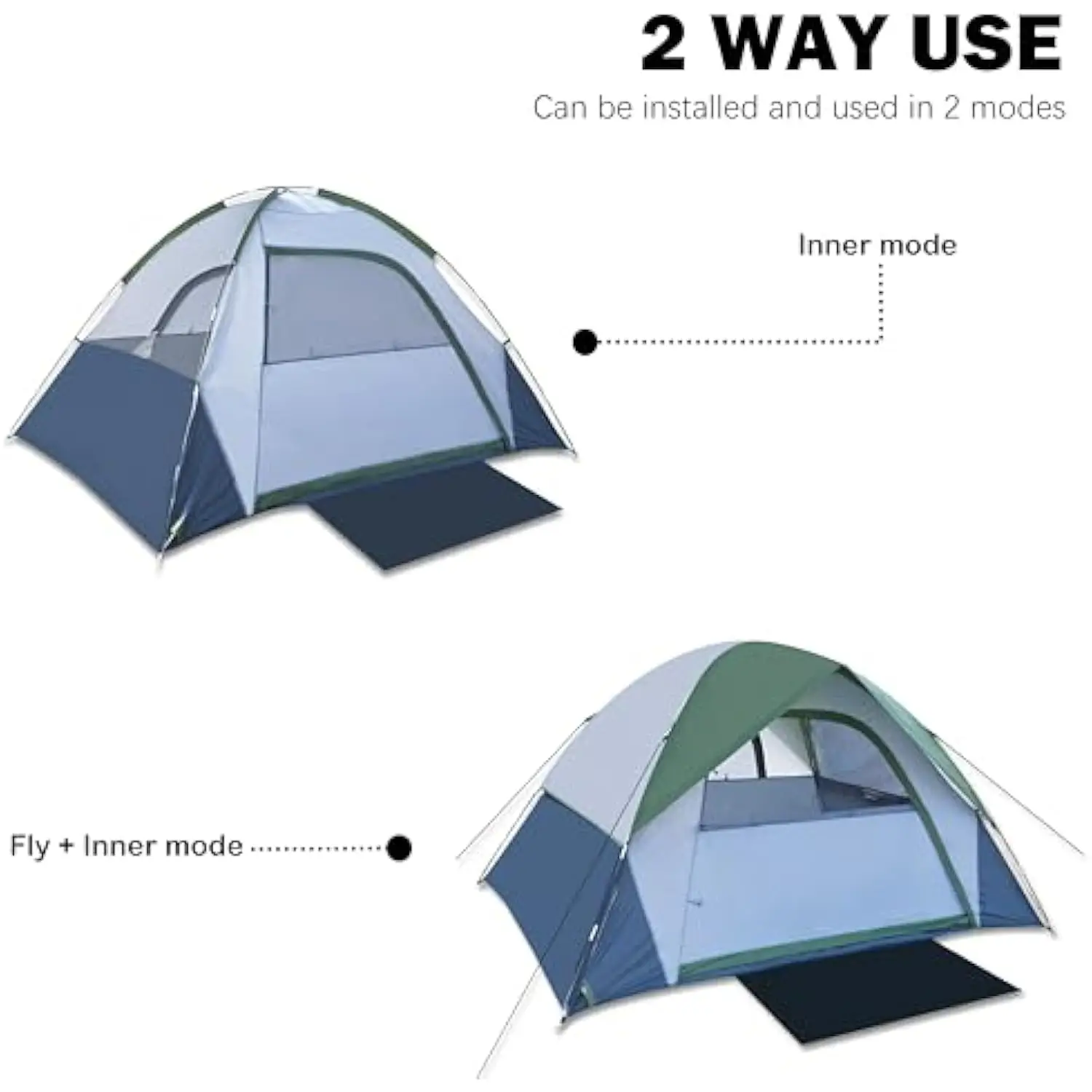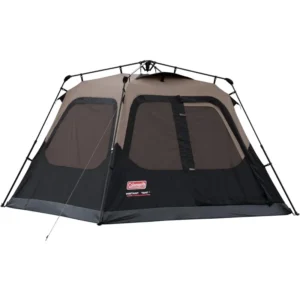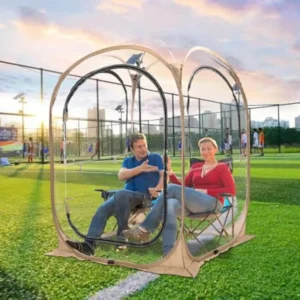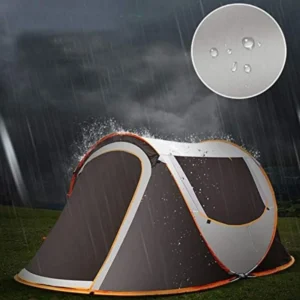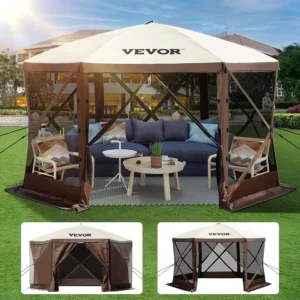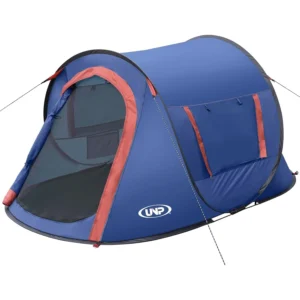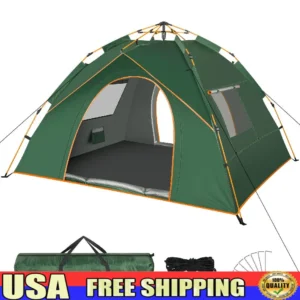What Makes a Pop-Up Tent Different? Understanding the Basics
Pop-up tents represent a revolutionary shift in camping shelter design, distinguished by their unique self-deploying structure. Unlike traditional tents that require manual pole assembly, pop-up tents feature a pre-assembled frame integrated directly into the tent fabric. This innovative design includes flexible, spring-loaded poles that are permanently attached to the tent material, allowing the structure to “pop” into shape when released from its carrying case.
The fundamental difference lies in the tent’s construction – the poles are already connected and positioned exactly where they need to be. When you remove the tent from its compact disc-shaped carrying case and release the securing straps or bands, the built-in tension in the frame causes the tent to spring open and take shape almost instantly.
What is a Pop-Up Tent?
A shelter with a pre-assembled, spring-loaded frame system that automatically deploys when released from its compressed state, eliminating the need for manual pole assembly and dramatically reducing setup time to mere seconds.
These convenient shelters go by several names in the outdoor market, including instant tents, quick-pitch tents, and self-erecting tents. Their development represents the evolution of tent design toward greater convenience without sacrificing the basic protection and shelter function that campers need. Understanding the unique characteristics of quick-pitch tents provides important context for appreciating their benefits in various outdoor scenarios.
The Top 8 Benefits of Pop-Up Camping Tents for Outdoor Enthusiasts
1. Unmatched Speed and Simplicity: From Bag to Shelter in Seconds
The most remarkable advantage of pop-up tents is their extraordinary setup speed. While traditional tents often require 15-30 minutes of sorting poles, threading them through sleeves, and securing guy lines, pop-up tents transform from packed to fully deployed in literal seconds – typically between 10 seconds and 2 minutes depending on the model.
This rapid deployment creates significant practical benefits:
- Immediate shelter during unexpected weather changes
- Setup possible in darkness without headlamps or flashlights
- Less time spent on campsite preparation means more time enjoying nature
- Reduced frustration when arriving at a campsite tired after a long journey
- Ability to quickly relocate your shelter if the initial spot proves unsuitable
For many outdoor enthusiasts, this time efficiency represents the ultimate convenience factor. The ability to pitch an instant tent with minimal effort transforms the camping experience, especially for those who value maximizing their time in nature. Families particularly benefit from this feature – anyone who has tried setting up a traditional tent with impatient children nearby knows that rapid setup for a two-person instant tent or larger family models can be the difference between a peaceful start to a camping trip and a stressful one.
2. Stress-Free Assembly: No More Instruction Manual Frustrations
The psychological benefits of eliminating complex setup procedures shouldn’t be underestimated. Pop-up tents free campers from the common frustrations associated with traditional tent assembly:
- No need to decipher confusing instruction manuals with tiny diagrams
- Elimination of color-coded pole systems that must be matched correctly
- No risk of incorrect assembly leading to structural weaknesses
- Freedom from the anxiety of missing components or broken pieces
- No specialized knowledge or technical expertise required
This accessibility makes pop-up tents particularly appealing to camping newcomers who might feel intimidated by the perceived complexity of outdoor gear. The design democratizes camping by removing technical barriers to entry. Even experienced campers appreciate how stress-free tents reduce the mental load of campsite setup, allowing them to focus immediately on relaxation or activities.
Perhaps most importantly, the simple setup reduces the potential for disagreements and frustrations between camping partners. Many camping trips have been temporarily soured by tensions arising during complicated tent assembly – pop-up tents eliminate this common source of conflict.
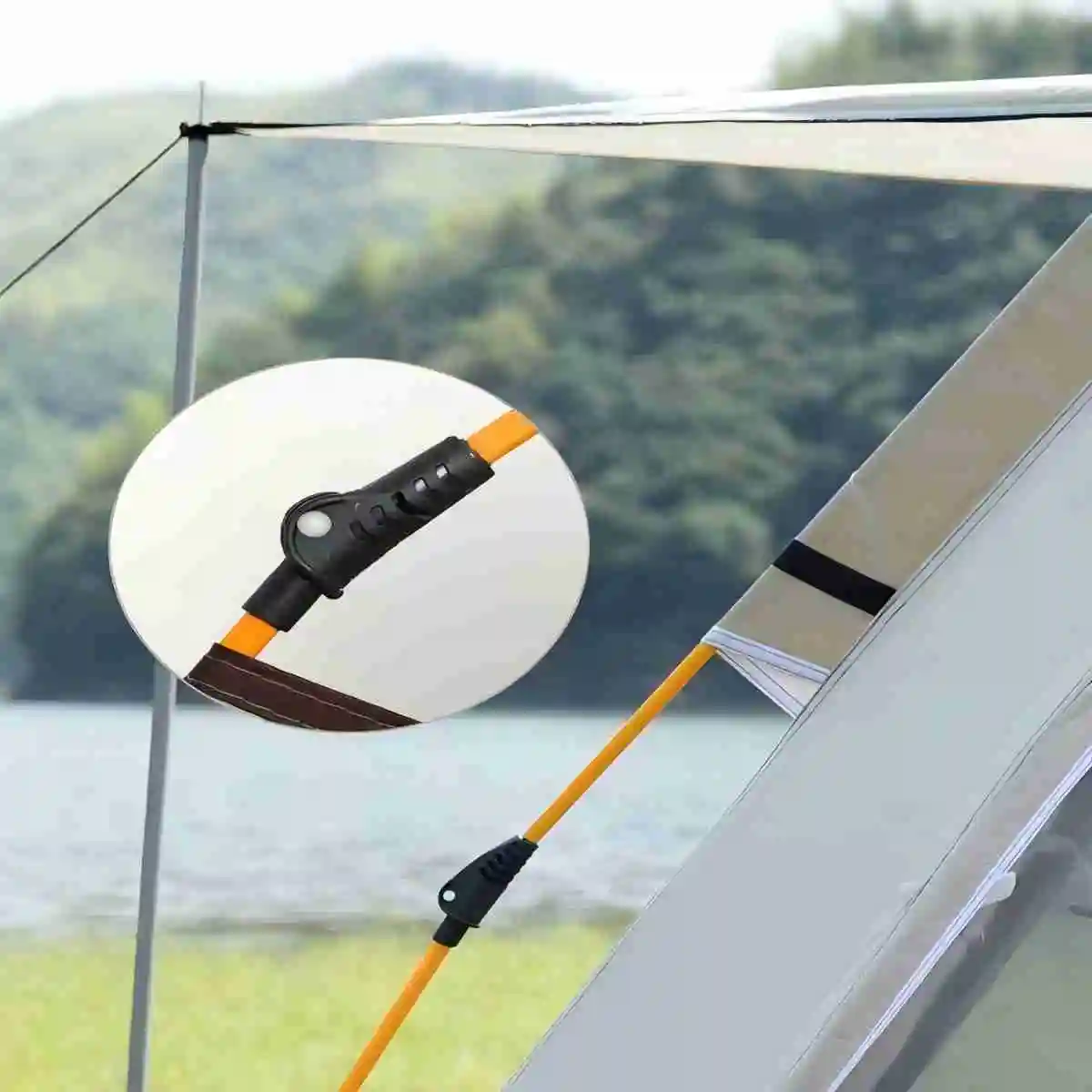
3. Simplified Packdown: Easier Than You Think
A common misconception about pop-up tents is that while they’re easy to set up, they’re challenging to pack away. While the folding technique does require learning a specific method, most users master it quickly with a bit of practice. The fold-and-twist technique typically involves:
- Flattening the tent into a circle shape
- Folding it in half to create a figure-eight
- Folding it once more to create a smaller circle
- Securing the folded tent with the provided straps or bands
The learning curve is short, and after a few practice attempts, most campers can confidently pack their pop-up tent away in just a couple of minutes. Manufacturer instructions and instructional videos make the process even more straightforward.
Unlike traditional tents, which require precise pole removal and careful fabric folding to fit back into their stuff sacks, pop-up tents eliminate the need to disassemble components. The integrated structure means you’re managing a single unit rather than multiple parts that could be misplaced or damaged during breakdown.
4. Ideal for Spontaneous Adventures and Quick Getaways
The convenience of pop-up tents makes them perfect companions for spontaneous adventures. Their rapid deployment capabilities particularly benefit:
- Weekend warriors with limited time for elaborate camping setups
- Road-trippers making multiple stops who need efficient camp changes
- Outdoor enthusiasts taking advantage of short weather windows
- Adventure seekers responding to last-minute camping opportunities
- Urban dwellers seeking quick nature escapes without extensive preparation
Pop-up tents enable a more flexible, adventure-ready lifestyle by removing one of the main logistical hurdles of camping. They can remain packed in a car trunk or home closet, ready for immediate use whenever the opportunity for outdoor adventure arises. This convenience aligns perfectly with the growing cultural trend toward micro-adventures – short, accessible outdoor experiences that fit into busy modern lifestyles.
For those who enjoy easy setup tents for weekend camping, pop-up models represent the ultimate convenience, allowing you to maximize limited time off by minimizing campsite logistics.
5. Perfect for Camping Newcomers and Families with Children
Pop-up tents significantly lower the barrier to entry for those new to camping. Their user-friendly design eliminates the technical knowledge traditionally required for tent setup, making the camping experience more accessible to:
- First-time campers intimidated by complex gear
- Families with young, impatient children who need immediate shelter
- Solo travelers who must handle all camp setup independently
- Seniors or individuals with physical limitations that make traditional tent assembly challenging
- Parents wanting to involve children in camping responsibilities without frustration
The simplicity of pop-up tents creates positive first experiences for camping newcomers, increasing the likelihood they’ll continue exploring outdoor activities. For families, the rapid setup means children witness less struggling and more enjoying, setting a positive tone for the camping experience.
The advantages of pop-up tents for two people extend to couples and friends who want to focus on quality time together rather than complicated setup procedures. The accessibility factor makes these tents particularly valuable for introducing new partners to camping without overwhelming them with technical requirements.
6. Portable and Lightweight Design for Easy Transport
Most pop-up tents offer excellent portability advantages. Typical models weigh between 4-8 pounds (1.8-3.6 kg) for smaller versions, making them manageable for most campers to carry. Their unique disc-shaped packed form, while sometimes bulkier in diameter than traditional tent tubes, creates several practical advantages:
- Easy storage in vehicle trunks and cargo areas
- Manageable transport on public transportation
- Comfortable carrying for short distances to campsites
- Space-efficient storage at home between adventures
- Simple handling without assistance
The compact nature of most pop-up tents makes them ideal companions for campers who value mobility and convenience. Whether you’re hiking a short distance from a parking area to a campsite or navigating public transport to a festival, the streamlined carrying experience enhances the overall adventure.
When finding your perfect quick-setup tent, consider how the packed size and weight align with your transportation methods and storage capabilities. While pop-up tents aren’t typically designed for backpacking due to their disc shape, they excel in almost every other transportation scenario.
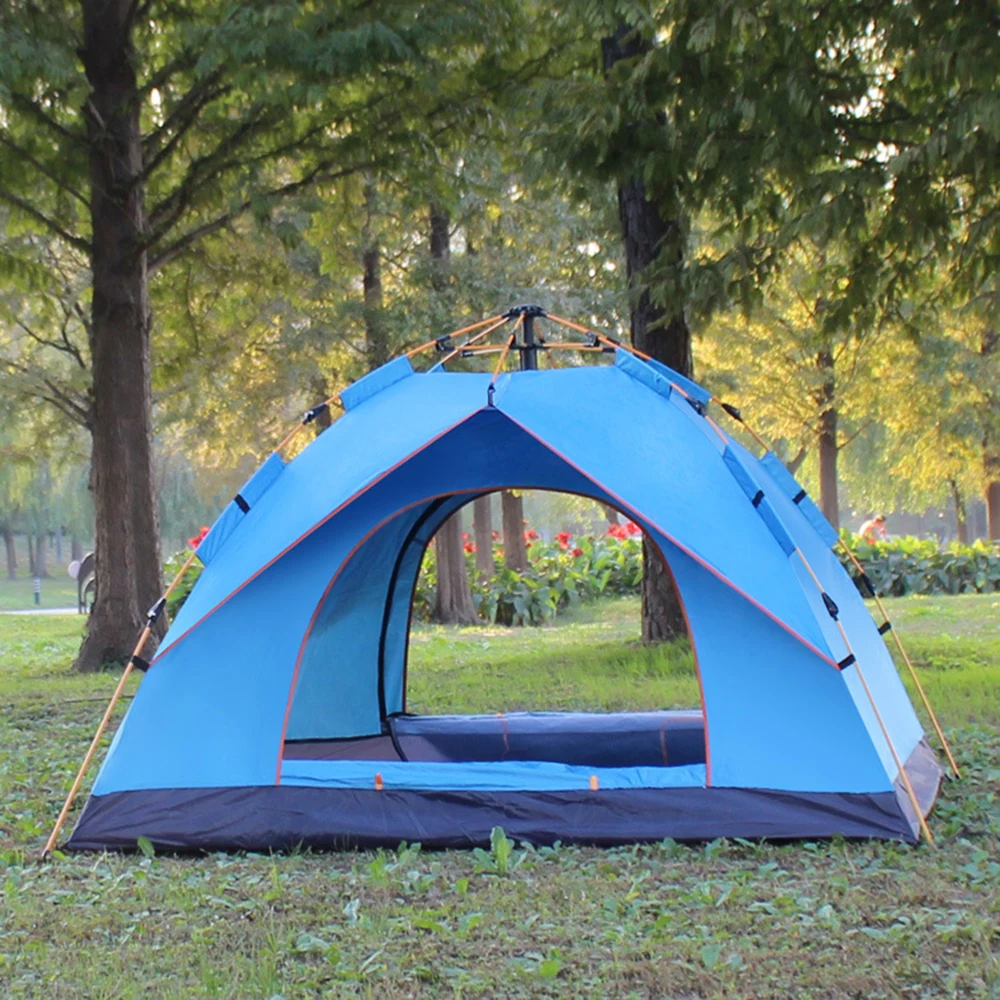
7. Cost-Effective Entry Point for Casual Camping
Pop-up tents generally represent an affordable entry point to camping compared to high-end traditional tents. This cost-effectiveness creates significant value for:
- Occasional campers who don’t need premium technical features
- Families testing whether camping suits their lifestyle before investing heavily
- Budget-conscious outdoor enthusiasts prioritizing function over advanced features
- Those needing secondary or guest tents for occasional visitors
- Parents purchasing starter tents for children’s backyard adventures
When considering the value equation, it’s important to analyze cost-per-use. For weekend warriors who camp several times annually, a pop-up tent often provides excellent return on investment. The simplified design typically means fewer components that could fail or require replacement, potentially extending the tent’s usable lifespan when properly cared for.
While serious expedition campers might prioritize specialized features worth the premium price, casual campers often find that pop-up tents deliver the essential shelter functions they need without unnecessary costs.
8. Versatility Beyond Traditional Camping
Pop-up tents offer remarkable versatility that extends well beyond conventional camping trips. Their rapid deployment and simple design make them suitable for numerous applications:
- Festival accommodation providing quick shelter between events
- Beach shelters offering sun protection and privacy
- Indoor play spaces for children during inclement weather
- Emergency shelters for unexpected situations
- Backyard camping for family “staycations”
- Temporary guest accommodations for home visitors
- Portable changing rooms for outdoor swimming or sports
- Photography blinds for wildlife observation
This multi-functional nature increases the value proposition significantly. Rather than purchasing separate specialized shelters for different activities, a single pop-up tent can serve many purposes. The ultimate guide to fast-setup tents explores these versatile applications in greater depth, highlighting how these adaptable shelters fit into various outdoor scenarios.
Easy Setup Camping Tent, Instant Camping Tent
Instant Cabin Tent Double Layer Canvas 1-Minute Setup Spacious Family Camping Shelter with Air Vents$308.10 Select options This product has multiple variants. The options may be chosen on the product pagePop Up Dome Tent, Waterproof Pop Up Tent
$218.89 Select options This product has multiple variants. The options may be chosen on the product page- $633.01 Select options This product has multiple variants. The options may be chosen on the product page
Easy Setup Camping Tent, Instant Camping Tent, Lightweight Pop Up Tent, Pop Up Dome Tent
$252.30 Select options This product has multiple variants. The options may be chosen on the product pageDome Camping Tent, Easy Setup Camping Tent, Pop Up Dome Tent, Waterproof Pop Up Tent
$162.68 Select options This product has multiple variants. The options may be chosen on the product page
Who Benefits Most From Pop-Up Camping Tents?
While pop-up tents offer advantages for many outdoor enthusiasts, certain groups find them particularly valuable:
- Casual and infrequent campers who prioritize convenience over specialized features and don’t want to relearn complex setup procedures between occasional trips
- Festival attendees needing quick shelter after long days of activities when energy levels are low
- Families with young children who benefit from immediate shelter without testing kids’ patience during setup
- First-time and novice campers seeking an accessible entry point to outdoor activities without technical barriers
- Car campers and road trippers who appreciate efficient setup and takedown during multi-stop journeys
- Beach and day-trip enthusiasts requiring temporary shelter that can be deployed and packed away quickly
- Parents introducing children to camping who want to create positive initial experiences without frustration
Understanding if you fit these profiles helps determine whether a pop-up tent aligns with your needs. For many, the convenience factors outweigh any limitations, especially when considering typical usage patterns and priorities. Many campers wonder about durability concerns such as whether pop-up tents are waterproof when evaluating if these shelters match their outdoor requirements.
Important Considerations Before Choosing a Pop-Up Tent
While pop-up tents offer significant benefits, understanding their limitations ensures appropriate expectations:
Weather Resistance Limitations
Pop-up tents typically offer adequate protection in mild conditions but have limitations in severe weather. Most entry-level models have lower hydrostatic head ratings (1500-2000mm) compared to technical camping tents (3000-5000mm+), meaning they resist light to moderate rain but may struggle in sustained downpours. Understanding the weather resistance of fast-pitch tents helps set appropriate expectations.
Durability Factors
The very mechanisms that make pop-up tents convenient – integrated poles and spring-loaded systems – can become points of vulnerability with frequent use. The constant tension on seams and connection points may lead to faster wear than traditional tents. Higher-quality models address these concerns with reinforced stress points and more durable materials.
Size Realities
Pop-up tents typically offer less usable interior space than their traditional counterparts of the same “person rating.” A “4-person” pop-up tent realistically accommodates 2-3 people comfortably with gear. This “sizing down” expectation helps avoid disappointment when planning accommodations.
Wind Stability Challenges
The lightweight nature and tall profiles of many pop-up designs make them more vulnerable to strong winds. While guy lines help, they generally don’t match the stability of low-profile traditional tents with external pole structures. Using natural windbreaks and proper staking becomes especially important.
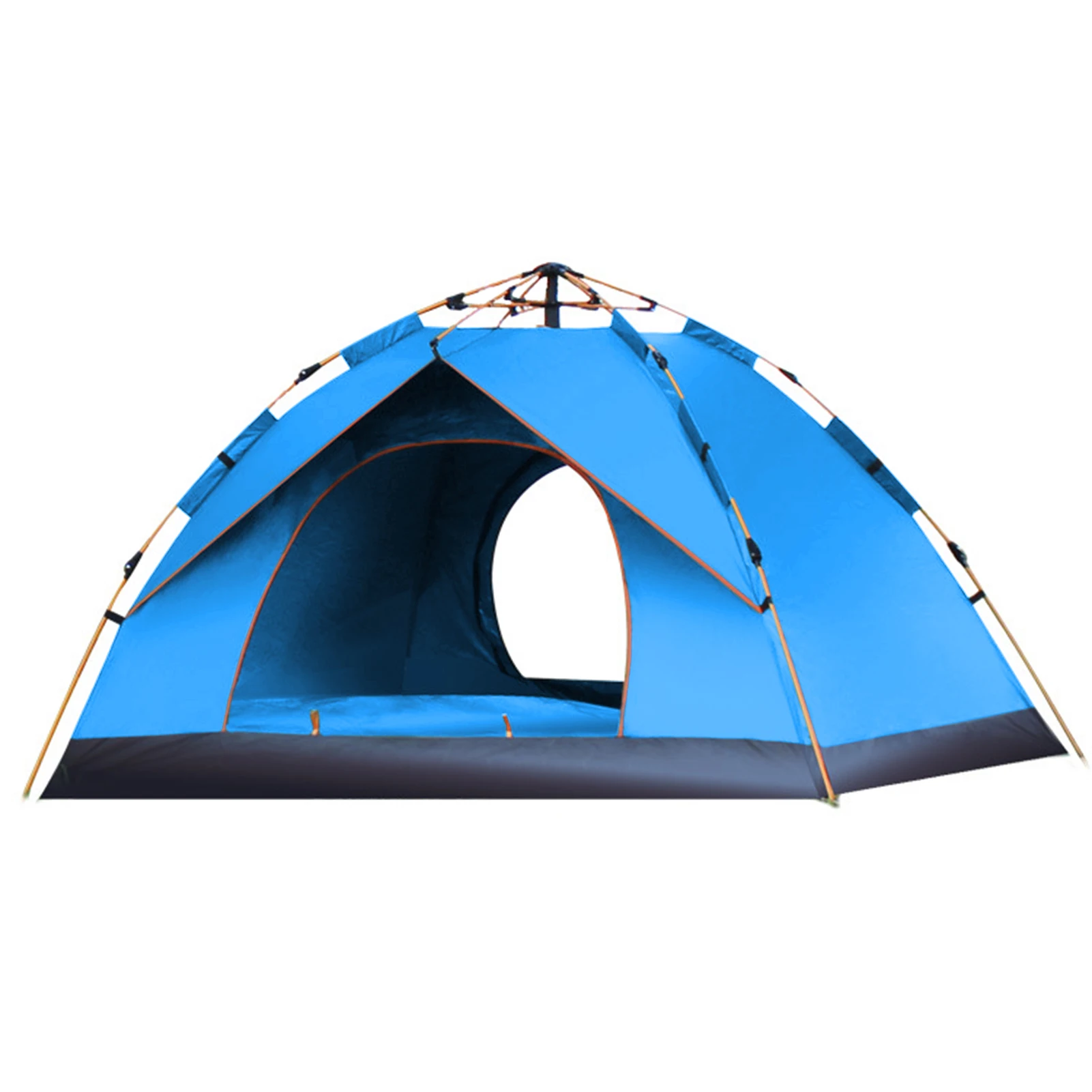
Ventilation Considerations
Some pop-up designs prioritize rapid deployment over ventilation features. Without adequate air flow, condensation can become problematic, especially in humid environments or when the tent is at full capacity. Models with multiple mesh panels and adjustable vents help mitigate this issue.
Lifespan Expectations
With proper care, quality pop-up tents typically last 2-5 years of regular use – generally less than premium traditional tents that might serve for 5-10 years. Understanding this helps set realistic expectations about the investment’s longevity.
What to Look for When Selecting Your Pop-Up Tent
To choose a pop-up tent that meets your specific needs, consider these key factors:
Water Resistance Features
Look for sealed seams, quality waterproof coatings (1500mm hydrostatic head minimum for light use), and a full-coverage rainfly that extends beyond the tent body. Water-resistant zippers and covered entrances provide additional protection.
Material Quality Indicators
Examine floor thickness (look for at least 110-120 denier fabric for durability), pole material quality, and reinforced stress points. Higher-quality models feature ripstop nylon or polyester that resists tearing and UV damage.
Ventilation Design
Prioritize models with multiple mesh panels, adjustable vents, and ground-to-ceiling airflow design. Adequate ventilation prevents condensation and improves comfort in various weather conditions.
Appropriate Sizing
Select a tent capacity at least 1-2 persons larger than your actual group size to accommodate gear storage and comfortable movement. Check interior height if sitting upright or changing clothes is important to your camping style.
Weight and Packed Size
Consider transportation methods and storage constraints. While most pop-up tents are lighter than traditional models, their disc shape when packed may require specific storage accommodations.
Additional Features
Look for interior pockets, gear lofts, electrical cord access ports, and vestibules for added convenience. Quality models include robust stakes, guy lines, and repair materials for field maintenance.
Is a Pop-Up Tent Right for Your Camping Style?
Determining whether a pop-up tent aligns with your outdoor needs requires honest assessment of your camping priorities:
A pop-up tent likely suits you if:
– Setup convenience ranks as your top priority
– You primarily camp in fair weather during spring through fall
– Your trips typically last 1-3 days
– You camp mainly at established campgrounds with vehicle access
– You value spontaneity and quick deployment
– You’re new to camping or introducing others to the activity
A traditional tent might serve you better if:
– Weather protection in extreme conditions is essential
– Your trips regularly extend beyond 3-4 days
– You camp in exposed areas with significant wind exposure
– You require maximum interior space efficiency
– You prioritize longevity and durability over convenience
– You need a shelter suitable for backpacking
Consider how these factors align with your typical camping scenarios. Many outdoor enthusiasts eventually own both styles – pop-up tents for quick weekend trips and traditional tents for extended adventures or challenging conditions. The best instant tent for outdoor adventures depends on your specific needs and priorities.
How Do Pop-Up Tents Compare to Traditional Camping Tents?
Understanding the direct comparison between pop-up and traditional tents helps clarify the trade-offs involved:
| Feature | Pop-Up Tents | Traditional Tents |
|---|---|---|
| Setup Time | 10 seconds – 2 minutes | 10-30+ minutes |
| Weather Resistance | Moderate; suitable for fair to mild conditions | Excellent; models available for extreme conditions |
| Durability | Good for occasional use; 2-5 year typical lifespan | Excellent; 5-10+ year potential lifespan with care |
| Space Efficiency | Less efficient; roomier models bulkier when packed | More efficient; better space-to-weight ratio |
| Wind Stability | Fair; vulnerable to strong gusts | Good to excellent; low-profile designs available |
| Weight | Lightweight but bulky when packed | Varies widely; ultralight to heavy options |
| Price Range | Generally affordable for basic models | Wide range from budget to premium |
| Learning Curve | Minimal; intuitive deployment | Moderate; requires practice for efficient setup |
This comparison highlights why many campers select specific tent types for different scenarios. A growing trend involves owning a 2-person pop-up tent for spontaneous weekend trips while maintaining a traditional tent for extended adventures. For those concerned about weight, lightweight pop-up tent options provide convenience without excessive bulk.
Different designs like the pop-up dome tent offer enhanced stability compared to other instant models, while waterproof pop-up tent options provide improved protection for varying conditions. The variety of instant camping tent styles ensures options for different camping priorities.
Frequently Asked Questions About Pop-Up Camping Tents
How long do pop-up tents typically last with regular use?
With proper care and maintenance, quality pop-up tents typically last 2-5 years with regular seasonal use. Protecting the tent from extended UV exposure, storing it completely dry, and careful handling of the spring mechanism all contribute to maximizing lifespan.
Can pop-up tents withstand rainy conditions?
Most quality pop-up tents can handle light to moderate rain, especially those with waterproofing ratings of 1500mm or higher. For sustained or heavy precipitation, additional waterproofing spray and properly installed rain flies become essential. Seam sealing significantly improves water resistance.
Are pop-up tents suitable for winter camping?
Most pop-up tents are designed for three-season use (spring through fall) and lack the structural strength and insulation for true winter conditions. Their design prioritizes easy setup over the robust construction needed for snow loads and extreme conditions.
How do I clean and maintain a pop-up tent?
Clean with mild soap and water (never machine wash), ensure the tent is completely dry before storage, store in a cool dry place away from direct sunlight, and periodically check and reinforce seams. Avoid dragging the tent on rough surfaces that could damage the waterproof coating.
Can I use a pop-up tent for backpacking?
Most pop-up tents aren’t ideal for backpacking due to their disc-shaped packed configuration, which doesn’t distribute well in or on backpacks. Their primary design focus is on setup convenience rather than pack efficiency required for wilderness backpacking.
By offering unmatched convenience and accessibility, pop-up tents have democratized camping for many outdoor enthusiasts. While they may not replace traditional tents for all scenarios, their unique benefits make them perfect companions for spontaneous adventures and casual camping experiences. As with all outdoor equipment, matching the tool to the task ensures the best experience – and for many casual campers, the pop-up tent represents the perfect balance of convenience and functionality.

